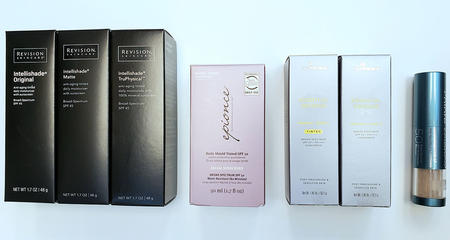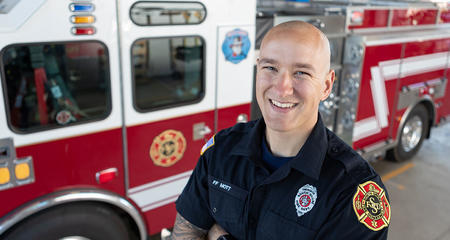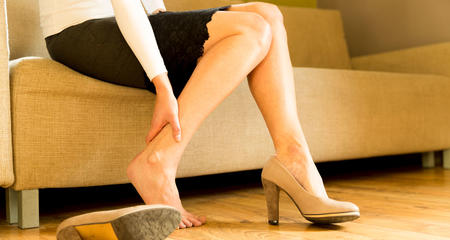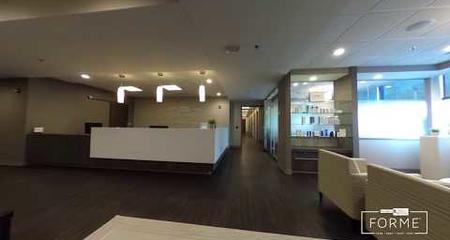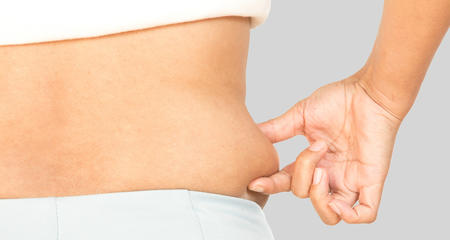

Eric J. Hohenwalter, MD, FSIR, interventional radiologist, and Michael Malinowski, MD, vascular surgeon, answer common questions about treating spider veins and varicose veins.
Watch now.
We specialize in the treatment of varicose veins and spider veins using a multidisciplinary approach, with a team of board-certified providers. Our goal is to help you understand your venous condition and offer the highest quality care to alleviate vein disorders.
We are proud to serve the community as the only academic medical center specializing in the treatment of venous disorders.
Varicose Veins
There is no known cause of varicose veins. Varicose veins develop when valves in the veins of the legs no longer function properly. Veins bring blood back to the heart, so there are one-way valves in the veins that direct blood toward the heart.
In the legs, these valves work harder because when a person is standing or sitting up, venous blood flow in the legs has to work against gravity. When the valves stop working properly, blood leaks through these valves and reverses its in direction in the legs. Veins dilate and bulge (varicose veins) from the pressure created by this downward flow. This reverse flow of blood (reflux) due to malfunction of vein valves is called venous insufficiency.
Varicose Vein Symptoms
People with varicose veins describe the following symptoms.
- Aching
- Burning
- Heaviness
- Swelling
- Itching
- Restlessness
These symptoms get worse with prolonged standing, sitting or walking, and usually at the end of the day. You can get relief with rest and elevation of the legs, pain medication, exercise (for some) and compression stockings.
Diagnosing Varicose Veins
The presence of varicose veins is a sign of venous insufficiency and is diagnosed with an ultrasound. This is a non-invasive test that detects if the valves in the veins of the legs are working properly.
If you have any questions regarding the presence of varicose veins on your legs or symptoms, you should talk a doctor about whether they need to be addressed. Typically, if you have no symptoms, most physicians do not treat them unless there are cosmetic concerns. Insurance companies do not pay for cosmetic treatment.
Spider Vein Symptoms and Causes
Spider veins appear on the surface of the skin. They may look like short, fine lines, “starburst” clusters or a web-like maze. Spider veins are most common in the thighs, ankles and feet, and may also appear on the face. They may itch, burn or ache, and can be found alone or in combination with varicose veins.
If you have spider veins and varicose veins on your legs, then the spider veins likely are associated with venous insufficiency. If you have only spider veins, they can be associated with family history, pregnancy, hormonal changes, trauma to the skin and obesity.
Spider Vein Diagnosis and Treatment
A doctor can perform a visual exam to identify spider veins. If you have cosmetic concerns or symptoms, you should speak with a doctor to see if you need treatment. Spider vein treatment is usually cosmetic, so check with your insurance regarding coverage.
Risk Factors for Varicose Veins and Spider Veins
The most consistent risk factors associated with the development of varicose veins and spider veins are:
- Family history
- Advanced age
- Pregnancy
- Female gender
- History of prior blood clots
There is some evidence that varicose veins are associated with obesity and occupations that require prolonged standing, sitting or heavy lifting. There is very weak evidence that varicose veins are associated with smoking, diet or crossing the legs.
Get Answers to Frequently Asked Questions
Treating Vein Disorders
Most problem veins — from the tiniest spider veins to the largest varicose veins — can be treated without surgery. Physicians use advanced technology and techniques to safely and efficiently treat vein disorders, with pleasing results for patients.
Any person who has unsightly spider or varicose veins is a candidate. Treatments include:
- Sclerotherapy — The procedure treats varicose veins by using a tiny needle to inject a solution (liquid or foam) directly into the veins. The solution irritates the lining of the veins, causing them to contract and collapse. Blood in these veins is directed back into deeper, normal veins.
- Microphlebectomy — A technique to remove varicose veins by making tiny incisions in the skin through which the varicose veins are removed. Stitches are usually not required.
- Endovenous ablation — A minimally invasive treatment for varicose veins that uses ultrasound guidance to apply a thermal energy or to inject medication into the vein in order to seal it closed so that blood may be diverted to other normal veins. Endovenous ablation will not only improve the cosmetic appearance of the legs, but can also help to relieve the aching, swelling and inflammation of the legs associated with varicose veins. Our team performs all the latest techniques in ablation treatment, including:
- Endovenous laser treatment
- Radiofrequency ablation
- VenaSeal™, which uses medical glue to seal off trouble veins
- Varithena™, which is a concentrated form of sclerotherapy used to treat larger veins
- Compression stockings — Compression stockings are recommended for those who have pain in their lower extremities due to swollen, enlarged veins. Compression therapy is often suggested as the first line of conservative treatment. FORME has a variety of stockings available for purchase without needing a prescription.
Depending on a person’s vein problem, treatment may involve one procedure or a few procedures. In most cases, patients can resume their normal activities the next day — or sooner.
Patients with spider veins and varicose veins often have other health problems in addition to their vein disorder, such as heart disease, diabetes and kidney disease. Our team of physicians works closely with a variety of specialists and with patients’ physicians to ensure coordinated care.
Your First Visit
During your first visit, one of our providers will conduct a comprehensive evaluation of your vein system, take your medical history and conduct a physical exam — which may include an ultrasound exam of the veins in your lower extremities. All of these processes combine to help the provider determine the optimal treatment plan for you.
Following the exam process, the provider will discuss your test results and review the treatment options appropriate for your disorder. Your treatment plan will be customized to your needs.
The diagnosis and treatment of significant health problems due to diseased veins are covered by most insurance companies if the problem is deemed "medically necessary." However, some venous conditions are considered cosmetic by some insurances, and may not be covered. We will determine if your vein disorder is causing health problems or if it is strictly cosmetic. It may take some time to work with your insurance to determine coverage.
As your treatment date nears, we will contact you with instructions, remind you to obtain compression stockings and answer any questions you have.
What to Expect for Your Vein Treatment
Please plan to arrive 15 – 30 minutes ahead of your scheduled procedure time, with the exact time depending on whether you opt for a mild sedative. You’ll remain awake and alert throughout the procedure, even if you choose to take the sedative. Upon arrival, you'll be asked to change into a gown, and this will require you to remove clothing from the waist down for the duration of the procedure.
Procedures involve a series of needlesticks, and almost all procedures use a local anesthetic. Once we administer the local anesthetic, you should not feel anything other than occasional pressure. Sclerotherapy does not need local anesthetic, as it is administered with a very fine needle.
You will be able to walk normally after your procedure. All procedures, except sclerotherapy, require that you have a driver to take you home. Your legs will be numb for a few hours until the local anesthetic wears off. After that, you will manage any discomfort with an over-the-counter pain medication or non-steroidal anti-inflammatory medication.
Follow-Up Care
For one week after treatment, you cannot lift items greater that 20 pounds or travel by plane. You should also not do strenuous exercise for a week. If your job requires any of these activities or that you stand for long periods of time, you should consider taking a few days off or request light duty.
For the first three days after a procedure, you will wear compression stockings day and night. On the fourth day you may shower and from this day, wear the compression stockings during the day for a total of three weeks minimum depending on your individual case/situation. Failure to wear compression stockings as prescribed could lead to the recurrence of spider or varicose veins. If you receive VenaSeal™ treatment, you may not need to wear compression stockings afterward, depending on your individual case/situation.
You should also avoid tanning or prolonged sun exposure before and after treatment.
Vein Treatment Risks
There is a very low risk of blood clots after your procedure — less than 1% in normal or low-risk patients. If you are on anticoagulation medication, you can remain on it for the procedure. If you are at risk to develop a blood clot, we may ask you to speak with a hematologist or vascular medicine specialist about taking an anticoagulant to reduce your risk.
As with any medical intervention, vein treatment involves potential side effects and complications. While these are uncommon, each patient should consult with his or her physician to determine if their condition presents any special risks and to understand the potential complications of a recommended treatment.
We will schedule a follow-up exam within one week of your procedure. You will have an ultrasound to check for blood clots. If we find a blood clot, we will have you take an anticoagulant and follow up with you again in one month with another ultrasound to make sure the blood clot has dissolved.
Insurance Coverage for Vein Treatment
Treatment of spider veins is often considered “cosmetic” and may not be covered by your health insurance. However, the diagnosis and treatment of significant health problems due to diseased veins are covered by most insurance companies if the problem is deemed “medically necessary.” An initial evaluation will be done to determine if your vein disorder is causing health problems or if it is strictly cosmetic. Our team will work with your insurance provider to determine your coverage. If it's determined your vein concerns are cosmetic only we will provide you an estimate of fees before scheduling your procedure.
FORME Aesthetic and Vein Center
All vein services — physician consultations, treatments and follow-up visits — are performed at the FORME Aesthetic and Vein Center. Here, our team of surgeons and vascular and interventional radiologists, combined with our advanced practice providers, deliver the latest in nonsurgical and surgical spider and varicose vein care options in a beautifully designed space. FORME is located in the Tosa Health Center.
